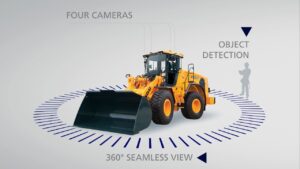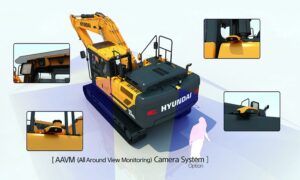Increase Jobsite Safety
With Onboard Cameras
Working in the construction industry can be highly risky. The U.S. Occupational Safety and Health Administration (OSHA) reports that 20% of worker fatalities are construction workers.
Moreover, a National Institutes of Health (NIH) study reveals that construction workers are 71% more likely to sustain injuries compared to workers in other fields.
So, what can be done to reduce job site injuries and increase jobsite safety?
Although OSHA regulations require audio alarms on heavy equipment, the chaotic nature of construction sites often makes it challenging for workers to hear these alarms amid the noise. This becomes even more difficult if workers wear hearing protection or use music buds.
Visual tools such as onboard cameras can play a crucial role in preventing accidents. This is because poor visibility is a major contributing factor to worksite mishaps.
The advanced onboard camera systems help minimize blind spots, allowing operators to have a better view of their surroundings, resulting in a safer site for equipment and, more importantly, people.
Let’s delve to learn more about onboard cameras and how they help increase jobsite safety.
Why Should You Use Onboard Cameras?

The onboard camera systems enhance jobsite safety by reducing blind spots and preventing accidental contact with equipment, objects, and people.
Also, it alerts operators when people are detected behind or near the machine. Safer operations often lead to various other advantages, such as:
- Fewer unwanted equipment/human interactions
- Increased operator confidence, leading to better speed, accuracy, and productivity.
- Reduced onsite spotter’s need, which minimizes risk and cuts labor expenses.
Types of Onboard Cameras
Onboard cameras have evolved into complete protection systems, outpacing their early ancestor dash cams.
What was once just a video recording device has morphed into aftermarket and factory-installed systems that enable operators to detect blind spots and hidden obstacles, prevent collisions, improve maneuverability, recognize people and objects, and predict their movements.
Nowadays, many renowned manufacturers like Kobelco, Hitachi, Hyundai, and Liebherr offer onboard cameras in their various heavy machinery and equipment.
Without further ado, here are a few types of onboard cameras that help elevate jobsite safety:
Smart Camera
Smart camera systems monitor people and notify operators of ever-changing site conditions. The intensity and frequency of audible and visual alarms increase as people approach the machine, reducing alert fatigue.
This onboard camera system is designed to withstand challenging conditions and can be customized to suit specific application needs.
How It Works:
This onboard camera system helps improve operator awareness and people protection. Here’s how it works:
- Mounted on the equipment, the smart camera detects people behind the machine, offering an additional pair of eyes.
- The operator is equipped with a high-definition touchscreen display that offers additional views of the surroundings and alerts when people are detected behind the heavy machine.
- Intelligent alerts signal operators about nearby individuals, with alert levels rising as proximity to the machine increases.
Surround Camera

The surround camera system helps operators work confidently and keep the ground crew safe and secure by providing operators with a bird’s eye view and greater situational awareness.
How It Works:
Not only does the surround camera increase awareness of potential blind spots but also various jobsite activities. Here’s how it works:
- Three to four rugged, vibration-resistant cameras are mounted on the machine’s exterior. The position of the cameras is towards the machine’s front, rear, sides, attachments, and buckets to enhance visibility.
- The cab features live images that allow operators to simultaneously view all camera angles, providing a comprehensive bird’s-eye view of the machine. Additionally, a larger, dedicated view is displayed on the left side of the screen.
Rear Camera
The rear camera system provides operators with an extra pair of eyes. It has a clear camera and a touchscreen display installed in the cab, offering a view of the machine’s rear. Greater visibility means reduced risks and increased productivity at your work site.
How It Works:
This onboard camera system uses various components to improve rear visibility and help the operator stay aware of their surroundings for safer navigation.
Here’s how:
- The machine has a rear-facing HD camera for improved operator visibility.
- The operators benefit from a high-resolution in-cab mounted display, enabling them to notice small, crucial details easily.
- Real-time transmission helps keep operators updated as events happen.
- View options provide operators an opportunity to see the rear display all the time or when the machine is in reverse only.
Takeaway
Incorporating onboard cameras into jobsite safety protocols is a smart and effective strategy to reduce injuries and create a safer work environment.
Not only does it helps reduce unwanted contact with people, equipment, or objects and minimize downtime, but it also increases work productivity.
So, choose heavy machinery with onboard cameras for safe, hassle-free construction work and projects.
